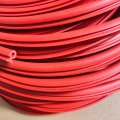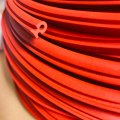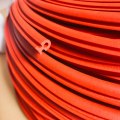Silicone Sponge Extrusion
- Description
Silicone sponge extrusion is a continuous manufacturing process used to produce flexible, foamed silicone rubber profiles with a uniform cellular structure. These profiles combine the excellent properties of silicone (high/low-temperature resistance, chemical inertness, UV stability, biocompatibility) with the compressibility, cushioning, and lightweight nature of a sponge.
Continuous Length: Ideal for gaskets, seals, and trims requiring long runs.
Uniform Cross-Section: Precise profile dimensions maintained along the length.
Cellular Structure: Provides compressibility, resilience, cushioning, thermal insulation, and acoustic damping.
Silicone Properties: Inherits heat resistance (typically -60°C to +200°C+), weather/UV resistance, chemical inertness, electrical insulation, low toxicity.
Flexibility & Conformability: Easily compresses to fill gaps and seal uneven surfaces.
Common Applications:
Seals & Gaskets: Door/window seals (appliances, automotive, building), enclosure gaskets (electrical, lighting, HVAC), flange gaskets.
Cushioning & Padding: Vibration dampers, protective padding, cushioning elements.
Thermal & Acoustic Insulation: Seals in hot/cold environments, sound dampening strips.
Medical & Food Grade: Tubing, seals for sanitary applications (requires specific platinum-cured, FDA/USP Class VI compliant compounds).
Specialty Profiles: Cord stock, edge trims, hollow tubes, complex custom shapes.
Advantages of Extrusion for Silicone Sponge:
Cost-Effectiveness: Efficient, high-volume production of continuous profiles.
Profile Complexity: Ability to create intricate cross-sectional shapes.
Consistency: Good control over dimensions, density, and cell structure along the length.
Material Efficiency: Minimal waste compared to molding processes for long parts.

 English
English
 Russian
Russian 






